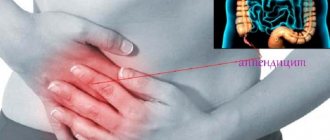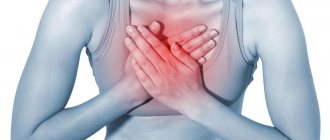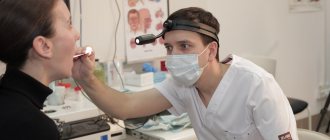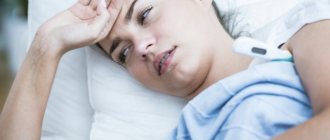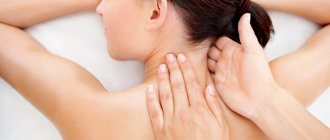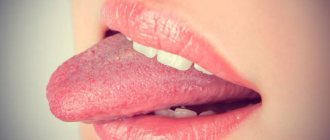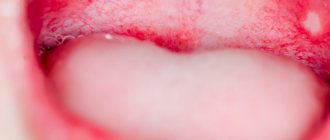Chills are a special condition that is manifested by muscle tremors and the appearance of “goose bumps”. Quite often, but not always, symptoms occur against the background of an increase in body temperature. When there is a chill without fever, the cause may be various inflammatory processes at the initial stage of development and other pathological conditions. Therefore, correct treatment can be carried out only after an accurate diagnosis has been made.
What to do if you have severe chills when your temperature rises
The feeling of cold caused by vascular spasms is called chills by doctors.
Most often, chills accompany colds, but other causes are possible. The causes of severe chills when the temperature rises can be infection, digestive disorders, internal bleeding, poor circulation, a jump in blood pressure and some chronic diseases.
Causes of chills without fever:
- hormonal changes (pregnancy, menopause);
- fear, stress;
- chronic diseases of the endocrine system can provoke sudden chills for no reason in the evenings;
- hypothermia
- overwork;
- injuries;
- metabolic disease.
A state of weakness and chills in a child most often occurs against the background of colds and viral diseases.
General information
Chills are a clinical manifestation of the reaction of enhanced thermogenesis, manifested by a subjective feeling of cold and acutely occurring transient trembling of the muscles of the shoulder girdle, limbs, back, masticatory muscles and spasm of the skin muscle fibers with raising of hairs and goosebumps (the “goose bumps” phenomenon caused by excitation of the n.vagus ).
Mild manifestations of chills are often called chills/chills. Chills, in fact, are a protective evolutionarily developed mechanism in the body, aimed at increasing heat production in the body. It is characteristic of a number of conditions in which heat production can either predominate over heat transfer (febrile states) or be insufficient relative to heat transfer (hypothermia).
Most often, chills occur with the development of a febrile reaction of infectious/non-infectious origin (in infectious, allergic, autoimmune processes, with parenteral introduction into the body of various pyrogenic substances - mucopolysaccharide complexes, foreign proteins, drugs) during treatment of the patient, during hypothermia, in stressful situations , changes in hormonal levels, etc. The sensation of a subjective feeling of chills is caused directly by a decrease in the temperature of the skin and irritation of cold thermoreceptors, signals from which are sent to the integrative thermoregulation center (hypothalamus).
Chills are based on the activation of mechanisms of contractile thermogenesis , limiting heat loss due to a specialized form of muscle activity - muscle yeast (involuntary volley contractions of different muscle groups) and narrowing (spasm) of the peripheral vessels of the skin with a decrease in the flow of warm blood, which helps to reduce the temperature of the skin and sweating. Incoming signals to the structures of the cerebral cortex form appropriate behavior - wrapping up, taking the appropriate pose.
Causes of "chilliness"
Vasospasm can be caused by both inflammatory diseases and psychological conditions. In the first case, chills most often occur in the evening and at night. It can “chill” with colds and viral diseases, hormonal imbalances, circulatory disorders and endocrine diseases. Chills, regardless of the time of day, are a “companion” of stress, emotional overstrain and overwork. Quite often, chills can be observed in women before the onset of menstruation (in this case, consultation with a gynecologist is necessary) and in the early stages of pregnancy. The cause of vascular spasm during pregnancy is hormonal changes in the body and the psychological experiences of the woman. Doctors consider slight chills in the early stages of pregnancy to be normal.
Consequences and complications
In general, chills are a protective-adaptive reaction of the body aimed at restructuring thermoregulation and maintaining a higher (increased) level of heat content and body temperature and in itself is biologically appropriate, since it activates metabolic and, by accelerating the process of oxidative phosphorylation, promotes the accumulation of energy reserves. Also, it is a kind of “signal” of the appearance of any pathological processes in the body or the need to adjust one’s lifestyle.
Causes of chills in children
The provoking factors in this case are acute respiratory diseases, food poisoning and urinary tract diseases. In adolescence, chills can occur against the background of vegetative-vascular dystonia and hormonal changes. In any of these cases, consultation with a specialist is necessary.
On our website you can make an appointment with the right specialist who will tell you why cold chills appear at night. At the clinic you can undergo a full examination of the body and take tests, including hormone tests.
Pathogenesis
The pathogenesis of chills in various diseases and in hypothermia is similar. It is based on a typical adaptive reaction of enhanced thermogenesis, which is aimed at increasing the temperature in the internal environment of the body by increasing heat production and reducing heat transfer to the external environment. An increase in heat production occurs due to frequent contractions of the fibers of individual groups of skeletal muscles, which is responsible for the appearance of tremors. In parallel, a general constriction of the blood vessels of the skin occurs, which leads to a sharp decrease, reduction/cessation of the sweating process, which significantly reduces heat transfer and subjectively causes a feeling of chilliness. The process of shivering thermogenesis and the vasomotor response are part of the thermoregulation mechanism.
Diagram of the thermoregulation mechanism
Chills are characteristic of the first febrile stage, accompanied by a rapid/gradual rise in body temperature. It is preceded by specific changes in the nerve centers that contribute to an increase in the “set point” in the thermoregulatory center, which is expressed by a change in the threshold of sensitivity of the neurons of the hypothalamus/thermoregulatory structures of the medulla oblongata to the afferent temperature (cold/heat) signals arriving to them. Accordingly, the above brain structures perceive normal temperature as low.
Signals from thermoregulatory structures, transmitted through the sympathetic nervous system and neurotransmitters, cause a narrowing (spasm) of the peripheral vessels of the skin/mucous membranes, which leads to inhibition of the process of sweating/evaporation and, as a consequence, to a sharp limitation of heat transfer and a decrease in skin temperature by several degrees. As a result, signals from peripheral thermoreceptors are perceived as “cooling”, which turns on the mechanisms of thermoregulation to increase body temperature, namely, the activation of the processes of contractile thermogenesis - a reflexively occurring tremor (contractions of individual groups of skeletal muscles).
There is trembling, a subjective feeling of cold - chills, coldness and pallor of the skin are noted, and “goose bumps” appear. Chills stop as the temperature rises - blood flow in the skin increases, muscle tremors stop, and heat exchange in the body is established at a higher level.
Causes of chills without fever in women
Climax. During this period, in addition to “hot flashes” (feelings of heat), a woman may experience chills, which is the result of hormonal “restructuring” of the body and a lack of “female” hormones. The solution to the problem is taking hormonal medications as recommended by a doctor.
Period. In addition to chills, some women before and during menstruation may experience weakness, nausea, headaches and abdominal discomfort. As a rule, the symptoms are mild and pass fairly quickly.
Pregnancy. As described above, in early pregnancy a woman may feel chills. The reason is hormonal changes in the body.
List of sources
- Human physiology: textbook. allowance. At 2 o'clock Part 2/F50 A. I. Kubarko [and others] Minsk: Vysh.shk., 2011.-625 p.
- Shanin, V.Yu. Fever and acute phase reaction / V.Yu. Shanin // Pathophysiology. – St. Petersburg: ELBI-SPb, 2005. – Ch. 7. – pp. 116–123.
- Agadzhanyan, N.A. Thermoregulation / N.A. Agadzhanyan [et al.] // Human Physiology. – M.: Medical Book, 2009. – Ch. 22. – pp. 302–316.
- Metko E. E., Kruglova T. V., Enko B. O., Mayboroda A. A., Luzikova Ya. S., Bondarevich A. V. Etiology and pathogenesis of febrile conditions // Young scientist. - 2021. - No. 16. — P. 62-64.
- Finogeev, Yu.P. Infectious diseases, treatment without chemistry / Yu.P. Finogeev [and others]. – St. Petersburg: Dilya, 2009. – P. 4.
Diagnosis and treatment
The doctor will be able to make the correct diagnosis after collecting anamnesis, examining the patient and receiving test results. If necessary, additional examination and consultation with highly specialized specialists will be prescribed.
Nausea, vomiting, headache require the following treatment:
- for hypertension - take medications prescribed by a doctor to normalize blood pressure;
- in case of emotional tension, stress - try to calm down, take a sedative, drink tea with mint, lemon balm or sage;
- If you have a cold, drink hot tea with raspberries and wrap yourself in a blanket. If there is no fever, you can take a hot foot bath;
- for menopause and menstruation - drink warm herbal tea;
- in case of hypothermia - a hot hour with honey, warm clothes.
What to do if an adult has constant chills? Your doctor will answer this question after receiving the examination results. Since there can be many reasons, treatment tactics are different in each case.
If you have health problems, undergo a complete examination of your body in our clinic, followed by consultation with a specialist. The doctor will tell you why cold chills appear at night and answer your questions. Call the above phone number or fill out an application on the website. We are always ready to help.
Symptoms
The appearance of chills is often preceded by progressive weakness, general malaise, and less commonly, aching muscles of the limbs/back. Before chills, many people note a feeling of chilliness, a symptom of “goose bumps” and goosebumps crawling on the skin. Later, general muscle tremors appear, which first occurs in the muscles of the face (tremor of the masticatory muscles) and neck, then in the torso and limbs. The skin turns sharply pale, cyanosis appears on the skin of the nasolabial triangle/lips, less often on the hands, knee joints, and feet. Body temperature rises several degrees.
The patient is cold and tries to warm up using blankets and warm clothes. There is an increase in heart rate, in some cases blood pressure increases, and nausea may occur. The severity of chills can vary significantly: from mild chills to severe chills, when literally “teeth chattering.” Severe chills, in particular severe chills at night, are characteristic of infectious diseases with a rapid increase in temperature. Severe chills in the elderly and children may be accompanied by convulsions, loss of consciousness, and tongue biting. As a rule, the duration of chills varies from several minutes to an hour, giving way to a feeling of heat, in some cases with profuse sweating.
The nature, frequency of occurrence and frequency of chills can vary significantly depending on the cause of its occurrence. Thus, a single chill often occurs in infectious diseases with an acute onset (influenza, ARVI, lobar pneumonia). Rhythmic alternation of fever with chills and fever-free periods are typical for tick-borne relapsing fever and malaria . Constant chills or periodic chills often occur with staphylococcal pneumonia , protracted forms of salmonellosis , infective endocarditis , brucellosis , sepsis , lung abscess , purulent pyelonephritis , bronchiectasis with suppuration, abscesses , cholangitis , nephritis , lymphogranulomatosis , erysipelas , malignant tumors.

